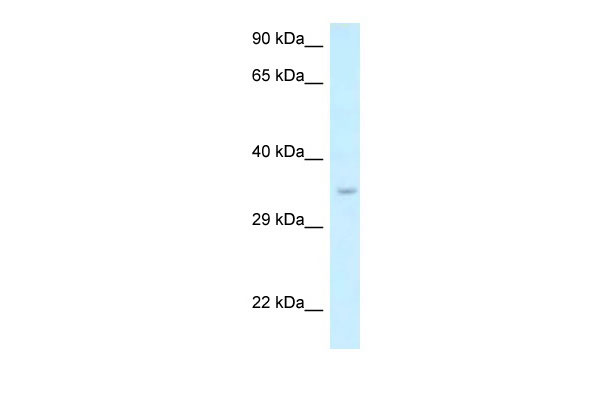Six1 antibody - N-terminal region
Rabbit Polyclonal Antibody
- 产品详情
- 实验流程
Application
| WB |
|---|---|
| Primary Accession | Q62231 |
| Other Accession | NM_009189, NP_033215 |
| Reactivity | Human, Mouse, Rat, Rabbit, Zebrafish, Pig, Dog, Horse, Bovine, Sheep |
| Predicted | Human, Mouse, Rat, Zebrafish, Pig, Chicken, Dog, Bovine, Sheep |
| Host | Rabbit |
| Clonality | Polyclonal |
| Calculated MW | 32210 Da |
| Gene ID | 20471 |
|---|---|
| Alias Symbol | BB138287 |
| Other Names | Homeobox protein SIX1, Sine oculis homeobox homolog 1, Six1 |
| Format | Liquid. Purified antibody supplied in 1x PBS buffer with 0.09% (w/v) sodium azide and 2% sucrose. |
| Reconstitution & Storage | Add 50 ul of distilled water. Final anti-Six1 antibody concentration is 1 mg/ml in PBS buffer with 2% sucrose. For longer periods of storage, store at 20°C. Avoid repeat freeze-thaw cycles. |
| Precautions | Six1 antibody - N-terminal region is for research use only and not for use in diagnostic or therapeutic procedures. |
| Name | Six1 |
|---|---|
| Function | Transcription factor that is involved in the regulation of cell proliferation, apoptosis and embryonic development (PubMed:12215533, PubMed:12668636, PubMed:12834866, PubMed:14628042, PubMed:14695375). Plays an important role in the development of several organs, including kidney, muscle and inner ear (PubMed:12668636, PubMed:12783782, PubMed:12834866, PubMed:14628042, PubMed:14695375). Depending on context, functions as a transcriptional repressor or activator (PubMed:14628042). Lacks an activation domain, and requires interaction with EYA family members for transcription activation (By similarity). Mediates nuclear translocation of EYA1 and EYA2 (By similarity). Binds the 5'-TCA[AG][AG]TTNC-3' motif present in the MEF3 element in the MYOG promoter and CIDEA enhancer (By similarity). Regulates the expression of numerous genes, including MYC, CCNA1, CCND1 and EZR (PubMed:16488997). Acts as an activator of the IGFBP5 promoter, probably coactivated by EYA2 (PubMed:11978764). Repression of precursor cell proliferation in myoblasts is switched to activation through recruitment of EYA3 to the SIX1-DACH1 complex (PubMed:14628042). During myogenesis, seems to act together with EYA2 and DACH2. Regulates the expression of CCNA1 (By similarity). Promotes brown adipocyte differentiation (PubMed:27923061). |
| Cellular Location | Nucleus {ECO:0000250|UniProtKB:Q15475}. Cytoplasm {ECO:0000250|UniProtKB:Q15475} |
| Tissue Location | Expressed in phalangeal tendons and in skeletal muscle and in head and body mesenchyme |
Research Areas
For Research Use Only. Not For Use In Diagnostic Procedures.
Application Protocols
Provided below are standard protocols that you may find useful for product applications.
终于等到您。ABCEPTA(百远生物)抗体产品。
点击下方“我要评价 ”按钮提交您的反馈信息,您的反馈和评价是我们最宝贵的财富之一,
我们将在1-3个工作日内处理您的反馈信息。
如有疑问,联系:0512-88856768 tech-china@abcepta.com.























 癌症的基本特征包括细胞增殖、血管生成、迁移、凋亡逃避机制和细胞永生等。找到癌症发生过程中这些通路的关键标记物和对应的抗体用于检测至关重要。
癌症的基本特征包括细胞增殖、血管生成、迁移、凋亡逃避机制和细胞永生等。找到癌症发生过程中这些通路的关键标记物和对应的抗体用于检测至关重要。 为您推荐一个泛素化位点预测神器——泛素化分析工具,可以为您的蛋白的泛素化位点作出预测和评分。
为您推荐一个泛素化位点预测神器——泛素化分析工具,可以为您的蛋白的泛素化位点作出预测和评分。 细胞自噬受体图形绘图工具为你的蛋白的细胞受体结合位点作出预测和评分,识别结合到自噬通路中的蛋白是非常重要的,便于让我们理解自噬在正常生理、病理过程中的作用,如发育、细胞分化、神经退化性疾病、压力条件下、感染和癌症。
细胞自噬受体图形绘图工具为你的蛋白的细胞受体结合位点作出预测和评分,识别结合到自噬通路中的蛋白是非常重要的,便于让我们理解自噬在正常生理、病理过程中的作用,如发育、细胞分化、神经退化性疾病、压力条件下、感染和癌症。







